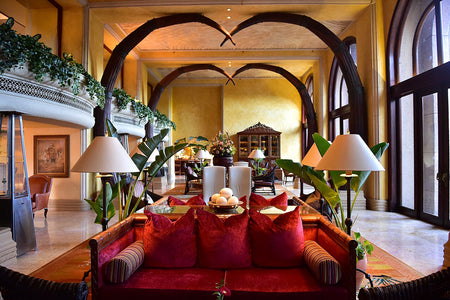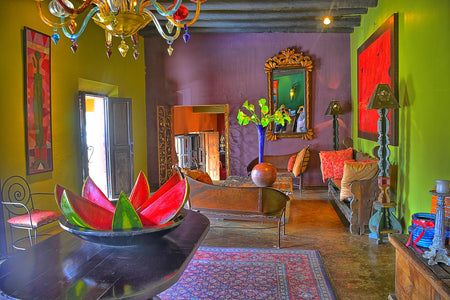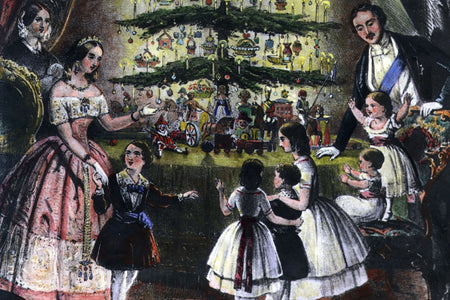
At Pooky we love how light can be used to create atmosphere and mood in a room. But of course artists have known this for centuries – and one of the most dramatic techniques developed by painters is chiaroscuro, the use of strong contrasts between light and dark. Here are four very fine examples of interiors from the golden age of chiaroscuro…
Caravaggio – Supper at Emmaus (1601)
The word ‘chiaroscuro’ is Italian for ‘light-dark’, and although the technique of using shading to create a three-dimensional effect originated over a hundred years earlier in Renaissance art, the undisputed king of chiaroscuro is Caravaggio (1573–1610). Caravaggio took the idea to new extremes and made strong shadows the dominant feature of his paintings, creating theatrical scenes featuring figures lit by a single light source against a pitch-black background. Many of his most famous paintings depict violent episodes from the Bible, but Supper at Emmaus gives us a different kind of drama. The scene shows the moment at which the resurrected Christ reveals himself to two of his disciples – who believed him to be dead – at a roadside inn. A light from the left illuminates Jesus’ face and the centre of the table, which includes a beautifully-realised still life of their supper, including a bowl of fruit which hangs alarmingly over the edge of the table. If you go to the National Gallery in London to check out this painting, you’ll see that it’s huge. The figures are life-size, and the outstretched arms of Jesus and the disciple on the right seem to pull you into the painting and, irresistibly, into Caravaggio’s pool of light.
Gerard van Honthorst – The Matchmaker (1625)
The use of extreme chiaroscuro – making very dark shadows the key element of a painting – is sometimes known as tenebroso (Italian for ‘murky’) but Caravaggio’s use of it was so influential that it is widely named after him. An early adopter of Caravaggism was the Dutch artist Gerard van Honthorst, who visited Rome as a portrait painter and returned a confirmed ‘carravaggisti’. The Matchmaker is a fine example – though in this case the light has a rather lewd meaning. The rich fellow in the foreground hands over his money to the attractive lady with the lute (an oft-used symbol of naughtiness in Dutch art), so the ‘matchmaker’ of the title is presumably the man lurking in the shadows on the left, waiting for his commission for making the introduction.
Johannes Vermeer – Girl with a Pearl Earring (1665)
This extremely famous portrait is almost certainly not actually a portrait at all, but a ‘tronie’ - a 17th Century Dutch device where artists depicted heads of imaginary stock characters (as opposed to portraying real people). And the earring probably isn’t pearl but polished tin (it’s likely too big and too reflective to be a pearl). She is, however, definitely a girl - and plenty of people have had great fun speculating on the life of the model and her relationship to Vermeer, notably in Tracy Chevalier’s novel Girl with a Pearl Earring, which was turned into a film starring perfectly-cast look-alike Scarlett Johansson as the subject. It’s hardly surprising that the painting has fascinated people: the Girl is perhaps second only to the Mona Lisa for hypnotic mystery of expression. But the striking chiaroscuro – in which her face is lit against a black background – may actually be accidental. When the picture was restored in 1994 it was discovered that the black was originally a deep green, but the pigments had faded over time.
Joseph Wright of Derby – An Experiment on a Bird in the Air Pump (1768)
Like Caravaggio’s Supper at Emmaus, this is another chiaroscuro gem of the National Gallery depicting a miracle - only this time it’s a miracle of science. The scene shows a ‘natural philosopher’ (an early mad scientist, basically) demonstrating one of Robert Boyle’s vacuum pumps. He proves that the air has been sucked out of the glass vessel at the top of the painting by putting a live bird in it, which duly suffocates to death. The characters are all lit by a single candle or lamp behind the bowl on the table, and the light cast upwards and outwards reveals a variety of reactions, from the cool philosophical interest of the men to the young girls’ horror at the plight of the poor cockatoo. The light is so dramatic and so important to the painting that it has been described as ‘the light of revelation’ – capturing a moment when a truth is shown to mankind, with all the wonder and terrible power that scientific discovery brings.
The use of chiaroscuro in painting may have peaked several centuries ago, but the technique is still much used, particularly in photography and film. A perfect example is film noir – have a read of our post about the cinematic use of light and lamps in the The Big Sleep: Shadows, lamps and criminal underworlds: why film noir looks so cool.
















